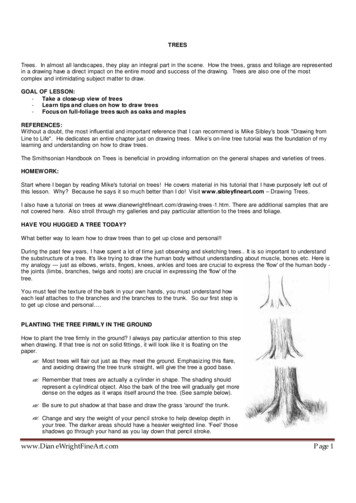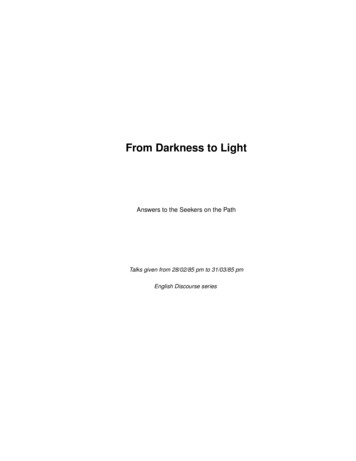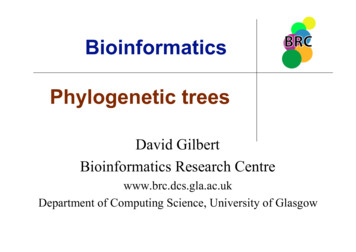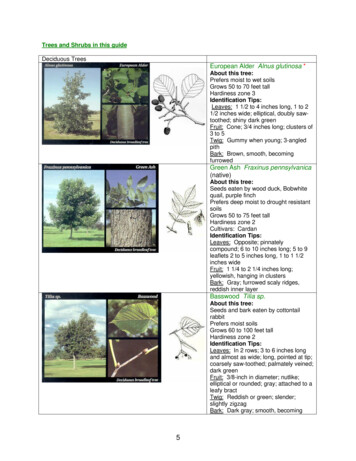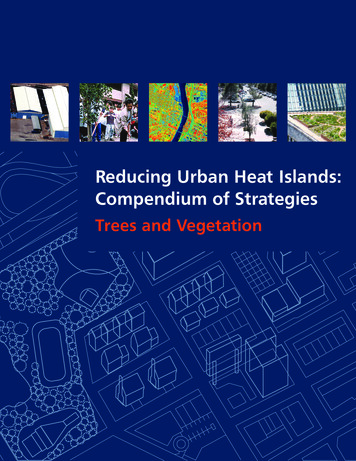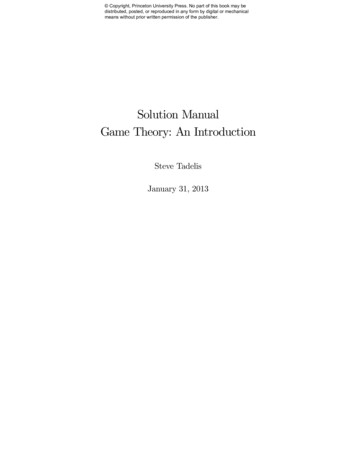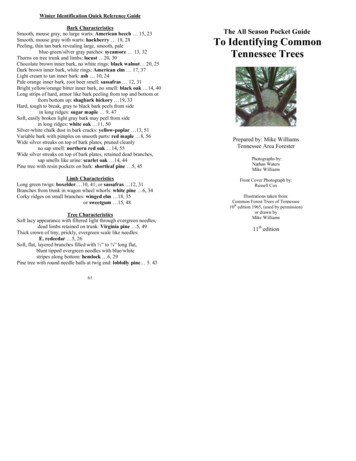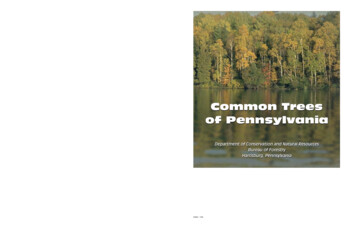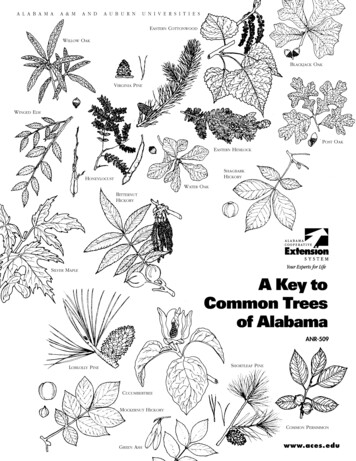
Transcription
A labamaA & MandA uburnU niversitiesEastern CottonwoodWillow OakBlackjack OakVirginia PineWinged ElmPost OakEastern HemlockShagbarkHickoryHoneylocustWater OakBitternutHickorySilver MapleA Key toCommon Treesof AlabamaANR-509Shortleaf PineLoblolly PineCucumbertreeMockernut HickoryCommon PersimmonGreen Ashwww.aces.edu
Eastern RedbudBlack WalnutChestnut OakBuckeye (Red)American BeechEasternRedcedarSouthern Red OakShumardLongleaf PineBlackLocustAmericanHollyoakAmerican ElmSouthernCatalpaSweetgumOvercup OakRed Maple Yellow-PoplarorTuliptree
Red MulberrySlash PineSycamoreWhite OakBaldcypressA Key to CommonTrees of AlabamaThis key can help you easily identify any of the 66 most common treesBlack Oakfound in Alabama. Keys such as this one, which is based on a series of choicesbetween two statements, are called dichotomous keys. This key was designed forRiver Birchuse during the growing season. Leaf and bark characteristics are the primaryEastern White Pinefeatures used for identifying trees.A listing of the common and scientific names for the 66 native trees is foundon page 9. This key will not work for trees that do not appear on this list. Thefollowing suggestions should help you as you begin working with the key:1) Always start at the beginning of the key and follow it step by step.Each choice will refer you to the next step, which may be a number, anothersection in the key, or the conclusion or species. It is a good practice to writedown your order of progress, such as 1 - 2 - 4. This will make it easier for youto find and correct mistakes.2) Always read both choices, even if the first choice sounds correct. Thesecond one may sound even better.3) If the choice between two statements is not clear, or you don’thave enough information to make the choice, follow both choices to theirconclusions. Then, try to choose between the descriptions of the tworesulting answers.4) Always look at several samples when keying a specimen. Key characteristics, especially leaves, can vary even on the same tree.5) When measurements are given, as in the size of the leaves, don’t guess.Use a ruler.6) Become familiar with the botanical terms used to describe trees. Termsused in this key are illustrated on pages 10 through 13.A Key to Common Trees of Alabama
Tree Identification Key1. Leaves needle-like or scale-like; trees’ with cones see Conifers1. Leaves flat and broad; trees without cones see HardwoodsConifers1. Leaves needle-like 21. Leaves scale-like, sometimes pointed on the endand prickly to the touch; bark reddish-brown andfibrous; cones look like bluish-gray berries about 1/4inch in diameter; cones occur only on female trees eastern redcedar2. Needles attached to the twig in bundles or clusters 32. Needles attached to the twig separately, not inbundles or clusters 43. Needles in bundles or clusters of 2 or 3 see Yellow Pines3. Needles in bundles or clusters of 5, 3 to 5 incheslong, bluish-green eastern white pine4. Needles yellow-green, 1 2- to 3 4-inch long; foliagehas a feather-like appearance and falls off in thewinter; bark fibrous, scaly, reddish brown butweathers to ash-gray, cones rounded like a ball; treeare found most commonly in swamps baldcypress4. Needles are borne on short stalks which remain onthe twig when needles fall off, shiny-green abovewith 2 white stripes underneath, 1/3- to 1/2-inch long;cones light-brown, borne on the ends of thebranches; trees evergreen; drooping branches mayhang to the ground eastern hemlockYellow Pines1. Needles in bundles or clusters of 3 21. Needles in bundles or clusters of 2 or 2 and 3 onthe same tree 32. Needles 5 to 9 inches long; cones 3 to 6 inches longand prickly to the touch loblolly pine2. Needles 8 to 18 inches long; cones large in size,6 to 10 inches long; seedlings look like clumps of grass longleaf pine3. Needles in bundles or clusters of 2 and 3 on the same tree 43. Needles in bundles or clusters of 2, 1 to 3 inches long 54. Needles small in size, 3 to 5 inches long; cones 1 to 3 inches long shortleaf pine4. Needles usually 8 to 12 inches long; cones 2 to 6 inches long slash pine5. Needles stout, yellow-green, twisted; cones 1 to 2 inches longand cone shaped; branches reddish; usually a very limby treeoften used as a Christmas tree Virginia pine5. Needles slender, dark green, twisted; cones 1 to 21 2 inches longand rounded; bark silver-gray, furrowed, more like the barkof a hardwood than a pine; trees usually found in stream bottoms spruce pine Alabama Cooperative Extension System
Hardwoods1. Leaves and buds opposite 21. Leaves and buds alternate . 72. Leaves compound . 32. Leaves simple . 53. Leaves pinnately compound . 43. Leaves palmately compound . buckeye4. Leaflet edges smooth (entire), not toothed . see Ashes4. Leaflet edges toothed (serrate) see Maples5. Leaves not lobed 65. Leaves lobed see Maples6. Leaves heart-shaped southern catalpa6. Leaves oval-shaped with a pointed tip . flowering dogwood7. Leaves compound . 87. Leaves simple 118. Leaflet edges smooth (entire), not toothed 98. Leaflet edges finely toothed (serrate) 109. Leaves once pinnately compound; twigs armed with unbranched thorns . black locust9. Leaves once and twice pinnately compound; twigs armedwith branched thorns, commonly 3-branched . honeylocust10. Leaves with 15 to 23 leaflets; fruit a yellow-green ball 11 2 to 2inches in diameter; bark gray-brown to black . black walnut10. Leaves with 5 to 17 leaflets, usually 15 or less . see Hickories11. Leaf edges smooth (entire), not toothed . . 1211. Leaf edges toothed (serrate) . . 2012. Leaves lobed . . 1312. Leaves not lobed . 1513. Leaves all approximately the same shape . 1413. Leaves mitten-shaped, 3-lobed and unlobed. on the same tree; barkdark reddish brown; leaves, twigs, and roots smell like root beer sassafras14. Leaf tip (apex) flat, leaves commonly 4-lobed, tulip-shaped; bark light gray . yellow-poplar14. Leaf tip (apex) pointed or rounded, leaves not 4-lobed . see Oaks15. Leaves heart-shaped, 3 to 5 inches in diameter; flower small and red;fruit a bean (legume), 2 to 3 inches long eastern redbud15. Leaves not heart-shaped, usually longer than broad . 1616. Leaf edges armed with sharp spines; fruit a red berry; tree evergreen . American holly16. Leaf edges not armed with sharp spines 1717. Twigs with narrow lines circling them near the place whereeach leaf is attached see Magnolias17. Twigs without narrow lines circling them 1818. Twigs with terminal buds at the ends 1918. Twigs without terminal buds at the ends; fruit an orange toreddish purple berry; bark looks like the back of an alligator common persimmon19. Leaf stem (petiole) which attaches leaf blade to twig less than1 4 inch long see Oaks19. Leaf stem (petiole) which attaches leaf blade to twig 1 to 2 inches long see TupelosA Key to Common Trees of Alabama
Hardwoods (cont.)20.20.21.21.22.22.23.Leaves not lobed 21Leaves lobed 30Twigs with terminal buds at the ends 22Twigs without terminal buds at the ends 25Primary veins extending from midrib to leaf margin 23Primary veins uniting within leaf blade 24Leaves triangular; buds brown and less than 3/4-inch long; bark atfirst yellowish green, smooth and thin, becoming thick gray anddeeply furrowed eastern cottonwood23. Leaves oblong to oval-shaped; buds brown, about 1 inch longand needle-like; bark thin, smooth, and gray, does not change withage; favorite tree bark for carving initials American beech24. Leaf edges very finely toothed (serrate) black cherry24. Leaf edges coarsely toothed (serrate) see Oaks25. Leaf edges simply serrate or dentately serrate 2625. Leaf edges doubly serrate 2726. Leaf edges simply serrate; leaves somewhat heart-shaped, 2 to 4 incheslong and 1 to 2 inches wide; bark gray-brown with corky warts hackberry26. Leaf edges dentately serrate; leaves 3 to 5 inches long and 2 to 3 incheswide with a heart-shaped or flattened base; bark grayish-brownand deeply furrowed with scaly ridges American basswood27. Bark reddish brown on very young stems and scaly or paperyon older stems 2827. Bark bluish gray to brownish gray and smooth or furrowed 2928. Bark turning white to salmon-pink and papery with age river birch28. Bark turning gray to brown and scaly with age eastern hophornbeam29. Bark bluish gray, tight, thin and smooth with a muscular appearance American hornbeam29. Bark ash-gray to brownish gray and furrowed see Elms30. Leaves star-shaped or nearly so 3130. Leaves mitten-shaped, 3-lobed and unlobed on the same tree red mulberry31. Leaf edges finely toothed (serrate); twigs often have corky wings;bark gray to gray-brown and deeply furrowed sweetgum31. Leaf edges irregularly toothed; twigs have a zigzag shape; barkcreamy white to brown and smooth to scaly sycamoreOaksThere are two broad groups of oaks, whiteoaksand red oaks. White oaks have leaves with roundedlobes and no bristles at the ends. Red oaks usuallyhave leaves with small bristles at the ends of thelobes and the leaf apex. Although it is sometimesdifficult to see the bristle-tips on the leaves, wateroak and willow oak belong to the red oak group.1. Leaf edges smooth (entire) 21. Leaf edges distinctly toothed or lobed 42. Leaf edges rolled under; undersurface hairy live oak2. Leaf edges not rolled under; undersurface not hairy 33. Leaves linear, 1 2 to 1 inch wide willow oak3. Leaves spatula-shaped, 1 to 2 inches wide; wider at the tip (apex) than at the base. water oak Alabama Cooperative Extension System
Oaks (cont.)4. Leaf tip (apex) and lobes usually rounded, if pointed not bristle-tipped 54. Leaf tip (apex) and lobes usually bristle-tipped 85. Leaf veins evenly spaced with each vein terminating in a lobe;leaf edges shallowly and evenly lobed; bark dark brown to black chestnut oak5. Leaf veins not evenly spaced; leaf edges deeply or irregularly lobed 66. Leaves leathery and rough to the touch, dark green, commonly5-lobed with 2 large central lobes giving leaves a cross-like appearance;bark thick, gray, blocky, or scaly post oak6. Leaves not leathery, smooth to the touch; some leaves with morethan 5 lobes, not cross-like 77. Leaves deeply and regularly lobed, 7 to 9 lobes, bright green;bark light gray and scaly; large acorns with cup enclosing one-fourth of nut white oak7. Leaves irregularly lobed and extremely variable, 5 to 9 lobes,dark green; bark gray brown, thick and rough; acorn cup almostcompletely encloses the nut overcup oak8. Leaves 3-lobed; lobes only in the upper half 98. Leaves 5- to 11-lobed, lobes in lower and upper halves 119. Leaf undersurfaces smooth, without hairs water oak9. Leaf undersurfaces covered with rusty red or orange hairs 1010. Leaves large; lobes broadly rounded blackjack oak10. Leaves bell-shaped; lobes narrow and somewhat pointed southern red oak11. Trees found on dry upland sites 1211. Trees found on moist sites, mainly in creek or river bottoms 1512. Leaf undersurface covered with rusty red hair; leaves irregular,5- to 7-lobed southern red oak12. Leaf undersurface green and smooth, often with tufts of hair inthe axils of principal veins, leaves more uniform 1313. Leaves dull green, 7- to 11-lobed; acorn cup saucer-shapedenclosing less than one-fourth of the nut northern red oak13. Leaves shiny green, 5 to 7-lobed (rarely 9-lobed); acorn cupbowl-shaped enclosing half of nut 1414. Leaves dark green, 5- to 7-lobed; bark dark brown to black, thickand furrowed; inner bark orange-yellow; buds large, coated withgray wooly hair black oak14. Leaves light green, 7-lobed (rarely 9-lobed); bark gray-brown toblack, broken into irregular ridges, inner bark reddish; budssmaller, covered with fine dark brown hair scarlet oak15. Leaf undersurface covered with grayish white to light brown hair;bark gray to black, flaky or scaly, resembling the bark of a cherry tree cherrybark oak15. Leaf undersurface green and smooth, often with tufts of hair inthe axils of principal veins; bark not resembling the bark of a cherry tree 1616. Bark whitish gray with scaly ridges separated by furrows;acorn cup saucer-shaped enclosing less than one-fourth of nut Shumard oak16. Bark dark gray-brown, broken into flat ridges; acorn cupbowl-shaped enclosing half of nut Nuttall oakA Key to Common Trees of Alabama
HickoriesHickories are divided into two broad groups, trueof true hickories have overlaping scales similar to fishhickories and pecan hickories. True hickories usuallyscales. Pecan hickories have valvate buds (bud scaleshave five to seven leaflets per leaf. Pecan hickoriesmeet at the edges and do not overlap).normally have nine to 17 leaflets per leaf. The buds1. Leaves usually with 7 or fewer leaflets (occasionally 9); buds covered withoverlapping scales 21. Leaves usually with 9 or more leaflets (occasionally 7); buds valvate (withoutoverlapping scales) 42. Leaves usually with 5 leaflets, occasionally 7 32. Leaves usually with 7 leaflets, occasionally 9 mockernut hickory3. Leaflets with hairy undersurfaces; bark bluish gray to grayand shaggy shagbark hickory3. Leaflets with smooth undersurfaces; bark deeply furrowed withnarrow interlacing ridges, ridges may be scaly at the surface pignut hickory4. Leaves with 7 to 11 leaflets, usually 9; buds sulfur-yellow bitternut hickory4. Leaves with 7 to 17 leaflets, usually 11 to 15; buds not sulfur-yellow 55. Leaves with 9 to 17 leaflets, usually 11 to 15; fruit a round,oblong, smooth nut, grown commercially for its sweet taste pecan5. Leaves with 7 to 13 leaflets, usually 11; fruit a flattened, rough,bitter nut water hickoryMaples1.1.2.2.Leaf edges variously toothed between lobes 2Leaf edges mostly smooth (entire) between lobes sugar mapleLeaf undersurface shiny (glabrous) red mapleLeaf undersurface silvery silver mapleTupelos1. Leaves 2 to 5 inches long; fruit usually in clusters of 2 or 3 blackgum1. Leaves 5 to 10 inches long; fruit solitary; trees usually have aswelled base; often growing beside cypress in standing water water tupeloElms1. Twigs with corky ridges or wings, more prominent on dryer sites,sometimes rare on moist sites; small, leaf 11 2 to 31 2 inches long winged elm1. Twigs without wings; leaves usually 4 inches long or longer 22. Leaves rough on the upper surface slippery elm2. Leaves smooth on the upper surface American elmAshes1. Leaves lustrous green above and below; lateral buds positionedabove a shield-shaped leaf scar green ash1. Leaves pale green above, sometimes silvery below; lateral budspartly surrounded by a U-shaped leaf scar white ashMagnolias1. Leaves leathery, upper surface shiny bright green, undersurfacecovered with rusty red wooly hair; flowers large, white, 6 to 8 inches wide southern magnolia1. Leaves not leathery, upper surface yellow-green, undersurfacesometimes hairy; flowers bell-shaped, greenish yellow, 2 to 3 inches wide. cucumbertree Alabama Cooperative Extension System
Common Trees of AlabamaThe following is a list of 66 trees that are foundin Alabama. It is not a complete list of all treesfound in the state. Trees are listed by preferred common name and scientific name (genus and species).Some trees are known by several different commonCommon NameScientific Nameboxelderred maplesilver maplesugar maplebuckeye (red)river birchAmerican hornbearnor blue beechwater hickorybitternut hickorypignut hickorypecanshagbark hickorymockernut hickorysouthern catalpahackberryeastern redbudflowering dogwoodcommon persimmonAmerican beechwhite ashgreen ashhoneylocustAmerican hollyblack walnuteastern redcedarsweetgumyellow-poplar or tuliptreeor tulip-poplarcucumbertreesouthern magnoliared mulberrywater tupeloblack tupelo or blackgumeastern hophornbeam orAmerican hophornbeamshortleaf pineslash pineAcer negundo L.Acer rubrum L.Acer saccharinum L.Acer saccharum Marsh.Aesculus spp.Betula nigra L.Carpinus caroliniana Walt.Carya aquatica (Michx. f.)Nutt.Carya cordiformis(Wangenh.) K. KochCarya glabra (Mill.) SweetCarya illinoinensis (Wangenh.)K. KochCarya ovata (Mill.) K. KochCarya tomentosa (Poir.) Nutt.Catalpa bignonioides Walt.Celtis occidentalis L.Cercis canadensis L.Cornus florida L.Diospyros virginiana L.Fagus grandifolia Ehrh.Fraxinus americana L.Fraxinus pennsylvanicaMarsh.Gleditsia triacanthos L.Ilex opaca AitJuglans nigra L.Juniperus virginiana L.Liquidambar styraciflua L.Liriodendron tulipifera L.Magnolia acuminata L.Magnolia grandiflora L.Morus rubra L.Nyssa aquatica L.Nyssa sylvatica MarshOstrya virginiana (Mill.)K. KochPinus echinata Mill.Pinus elliottii Engelm.names, but each has a unique scientific name. If youare not familiar with a common name used in thislist or in the key, you may wish to find it in anotherreference by looking up the scientific name.Common NameScientific Namespruce pinelongleaf pineeastern white pineloblolly pineVirginia pinesycamoreeastern cottonwoodPinus glabra Walt.Pinus palustris Mill.Pinus strobus L.Pinus taeda L.Pinus virginiana Mill.Platanus occidentalis L.Populus deltoides Bartr.ex Marsh.Prunus serotina Ehrh.Quercus alba L.Quercus coccinea Muenchh.Quercus falcata Michx.Quercus pagoda Raf.(formerly known asQuercus falcata var.pagodaefolia Ell.)Quercus lyrata Walt.Quercus marilandicaMuenchh.Quercus nigra L.Quercus texana Buckl.(formerly known asQuercus nuttalli Palmer)Quercus phellos L.Quercus prinus L.Quercus rubra L.Quercus shumardii Buckl.Quercus stellata Wangenh.Quercus velutina Lam.Quercus virginiana Mill.Robinia pseudoacacia L.Sassafras albidum (Nutt.)NeesTaxodium distichum var.distichum (L.) Rich.(formerly known asTaxodium distichum (L.)Rich)Tilia americana L.Tsuga canadensis (L.) Carr.Ulmus alata Michx.Ulmus americana L.Ulmus rubra Muhl.black cherrywhite oakscarlet oaksouthern red oakcherrybark oakovercup oakblackjack oakwater oakNuttall oakwillow oakchestnut oaknorthern red oakShumard oakpost oakblack oaklive oakblack locustsassafrasbaldcypressAmerican basswoodeastern hemlockwinged elmAmerican elmslippery elmThe tree identification key was adapted from Guide To Southern Trees by Ellwood S. Harrar and J. George Harrar;Trees, Shrubs, & Woody Vines of East Texas by Elray S. Nixon and Bruce L. Cunningham; and Forest Trees. A Guide tothe Southeastern and Mid-Atlantic Regions of the United States by Lisa J. Samuelson and Michael E. Hogan.A Key to Common Trees of Alabama
Leaf TypesPinnately Compound LeafSimple Leaftip (apex)leafletsedge (margin)rachisveinsbladebasestem (petiole)Green AshTwice Pinnately Compound LeafPalmately Compound LeafHoneylocustRed BuckeyeLeaf ArrangementOppositeAlternateSilver MapleAmerican Beech10 Alabama Cooperative Extension System
Leaf Shapeslinearheart-shapedRedbudWillow Oakspatula-shapedbell-shapedSouthern Red Oak(notall leaves of thespecies are bell shaped)Water Oakcross-liketriangularPost OakCottonwoodA Key to Common Trees of Alabama 11
Leaf Shapes continuedmitten-shapedstar-shapedRed Mulberry(notall leavesof the species scale-likeneedle-likeEastern Red CedarLoblolly Pine12 Alabama Cooperative Extension System
Leaf Shapes continuedtulip-shapedYellow PoplarLeaf Edges (Margins)smooth (entire)bristle-tippedtoothed (serrate)lobeddentately serratedoubly serrateunlobedA Key to Common Trees of Alabama 13
Laurel OakMimosaHawthornRed HickoryChinese ElmSweet BayChina FirOther common trees not listed in the key.YauponLombardy PoplarWeeping WillowAtlantic-White CedarBlack WillowSilver PoplarDeodar CedarKathryn Flynn, Extension Forester and Coordinator, Mosley Associate Professor,Forestry and Wildlife Sciences, Auburn University. Originally prepared by Frank A.Roth II, former Forest Management Specialist, and Larkin H. Wade, former ExtensionForester. Illustrations by Romaine S. Crockett, former Extension InformationSpecialist/Art.For more information, call your county Extension office. Look in your telephone directory under your county’s name to find the number.ANR-50914Issued in furtherance of Cooperative Extension work in agriculture and home economics, Acts of May 8 andJune 30, 1914, and other related acts, in cooperation with the U.S. Department of Agriculture. The AlabamaCooperative Extension System (Alabama A&M University and Auburn University) offers educational programs,materials, and equal opportunity employment to all people without regard to race, color, national origin, religion, sex, age, veteran status, or disability.15M, Revised May 2007, ANR-509 2007 by the Alabama Cooperative Extension System. All rights reserved.
Norway MapleSparkle BerryPin OakSourwoodSwamp Chestnut OakTungPaintedBuckeyeCrab AppleCabbagePalmettoCherry LaurelChestnutButternutGinkgoA Key to Common Trees of Alabama 15
Slippery ElmBoxElderSassafrasSugar MapleFlowering DogwoodSouthern MagnoliaLive OakBlack CherryPecanBlack OakCherrybark OakNorthern Red OakBlack Tupeloor BlackgumPignut HickoryAmerican BasswoodWhite AshHackberry
A Key to Common Trees of Alabama ANR-509 A L A B A M A A & M A N D A U B U R N U N I V E R S I T I E S www.aces.edu COmmOn PErsimmOn shOrtlEaf PinE grEEn ash mOCkErnut hiCkOry CuCumbErtrEE lOblOlly PinE silvEr maPlE bittErnut hiCkOry hOnEylOCust WingEd Elm WillOW Oak virginia PinE WatEr Oak EastErn hEmlOCk shagbark hiCkOry POst Oak blaCkjaCk Oak EastErn COttOnWOOd livE Oak

